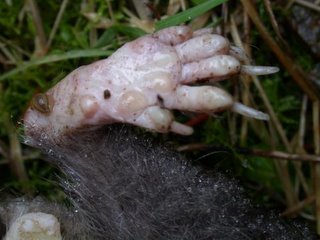 Shortly before our trip to California, we had the opportunity to make our own bows. We started out with a hickory board pre-cut by our instructor into a general bow shape. Our task was to then remove wood using files and sandpaper until we were satisfied with the result. Rounding the corners, smoothing the faces and making notches for the string were straightforward tasks, but when we finished those we were left with the difficult part of bow making: tillering. Tillering is the process of making the top and bottom limb of the bow even in strength. If one limb is stronger than the other it can have a detrimental affect on how the bow shoots. You can see that my bow is not evenly balanced - the limb at the bottom of the picture (which is actually the top of the bow) curves more gently than the limb at the top of the picture. The way to balance that out would be to weaken the stronger limb by shaving wood from its belly (the inner surface). I chose not to do that for two reasons. One is that the instructor said that some people prefer to have the top limb a bit weaker because the balance point of the bow is actually closer to the top than the bottom so the bottom limb has farther to travel so could stand to be stronger (at least that's what I understood from what was said). The second reason was that initially the limbs were uneven in the opposite direction and I took a lot of wood off (testing periodically) until suddenly the limbs were reversed in strength. I took a little bit of wood off the now stronger limb, but it didn't appear to have much of an affect and I was afraid the same thing would happen and I would end up with a bow much weaker than I wanted.
Shortly before our trip to California, we had the opportunity to make our own bows. We started out with a hickory board pre-cut by our instructor into a general bow shape. Our task was to then remove wood using files and sandpaper until we were satisfied with the result. Rounding the corners, smoothing the faces and making notches for the string were straightforward tasks, but when we finished those we were left with the difficult part of bow making: tillering. Tillering is the process of making the top and bottom limb of the bow even in strength. If one limb is stronger than the other it can have a detrimental affect on how the bow shoots. You can see that my bow is not evenly balanced - the limb at the bottom of the picture (which is actually the top of the bow) curves more gently than the limb at the top of the picture. The way to balance that out would be to weaken the stronger limb by shaving wood from its belly (the inner surface). I chose not to do that for two reasons. One is that the instructor said that some people prefer to have the top limb a bit weaker because the balance point of the bow is actually closer to the top than the bottom so the bottom limb has farther to travel so could stand to be stronger (at least that's what I understood from what was said). The second reason was that initially the limbs were uneven in the opposite direction and I took a lot of wood off (testing periodically) until suddenly the limbs were reversed in strength. I took a little bit of wood off the now stronger limb, but it didn't appear to have much of an affect and I was afraid the same thing would happen and I would end up with a bow much weaker than I wanted.Most of the class was able to finish their bows with a bit of time left over to shoot them. We watched a video on instinctive shooting and went to it. I was able to shoot relatively accurately from around 5 to 10 paces (the distance recommended to us for starting out at).
It was a long couple of days with a lot of work and some large batches of frustration, but it was a really good feeling to come out of it with a working bow made by my own hands.


